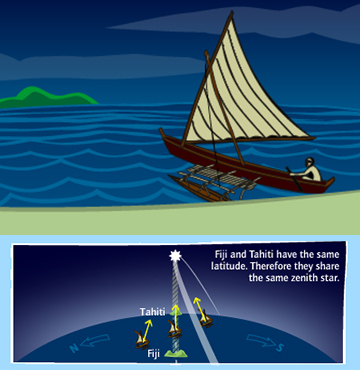The Canoe Is the People
Indigenous Navigation in the Pacific
Zenith Star
Stars cross the sky from east to west. They are at their zenith when they appear to reach their highest point. Certain stars are known to pass directly above specific islands when they are at their zenith. These stars are called zenith stars. Hokulea (Arcturus) is a zenith star for Hawaii Island. Aa (Sirius) is a zenith star for Tahiti and Fiji. When wayfinders sight the mast GLOSSARY mast - the vertical pole that holds the sail and see Aa directly overhead, they knowsthat they are at the same latitude as Fiji and Tahiti. The zenith star cannot tell them however, how far they may be to the east or west of these islands.
Some people believe that in the past wayfinders memorized the zenith stars of different islands as well as the time distances between them. For example, on a voyage from Tahiti to Hawaii, a wayfinder knew that the vaka was level with Nuku Hiva (Te Henua Enana GLOSSARY Te Henua Enana - Marquesas Islands ) in the east when they were under the star Mataatau (Rigel).
Zenith stars can be useful for finding land. On north-south journeys, wayfinders can sail upwind GLOSSARY upwind (windward) - on the side that the wind is coming from of the destination island until its zenith star is right above them. (That is, if the wind is coming from the east, they sail to the east side of the island.) Then, they turn downwind GLOSSARY downwind (leeward) - in front of the wind, that is, on the side opposite where the wind is coming from , keeping the zenith star above them. The wayfunder sails along this east-west path until land is found. Sometimes the vaka must zigzags GLOSSARY zigzags - back and forth to increase the finding range.
“On the first voyage of Hokulea to Tahiti in 1976, David Lewis and I used Spica (the zenith star for Te Henua Enana (Marquesas Islands)) to tell when we were opposite that archipelago (group of islands). We sighted up the after mast until Spica was framed by the masthead. We couldn’t use Aa (Sirius), the zenith star for Tahiti, because it wasn’t visible at the time.”
Anthropologist Ben Finney






